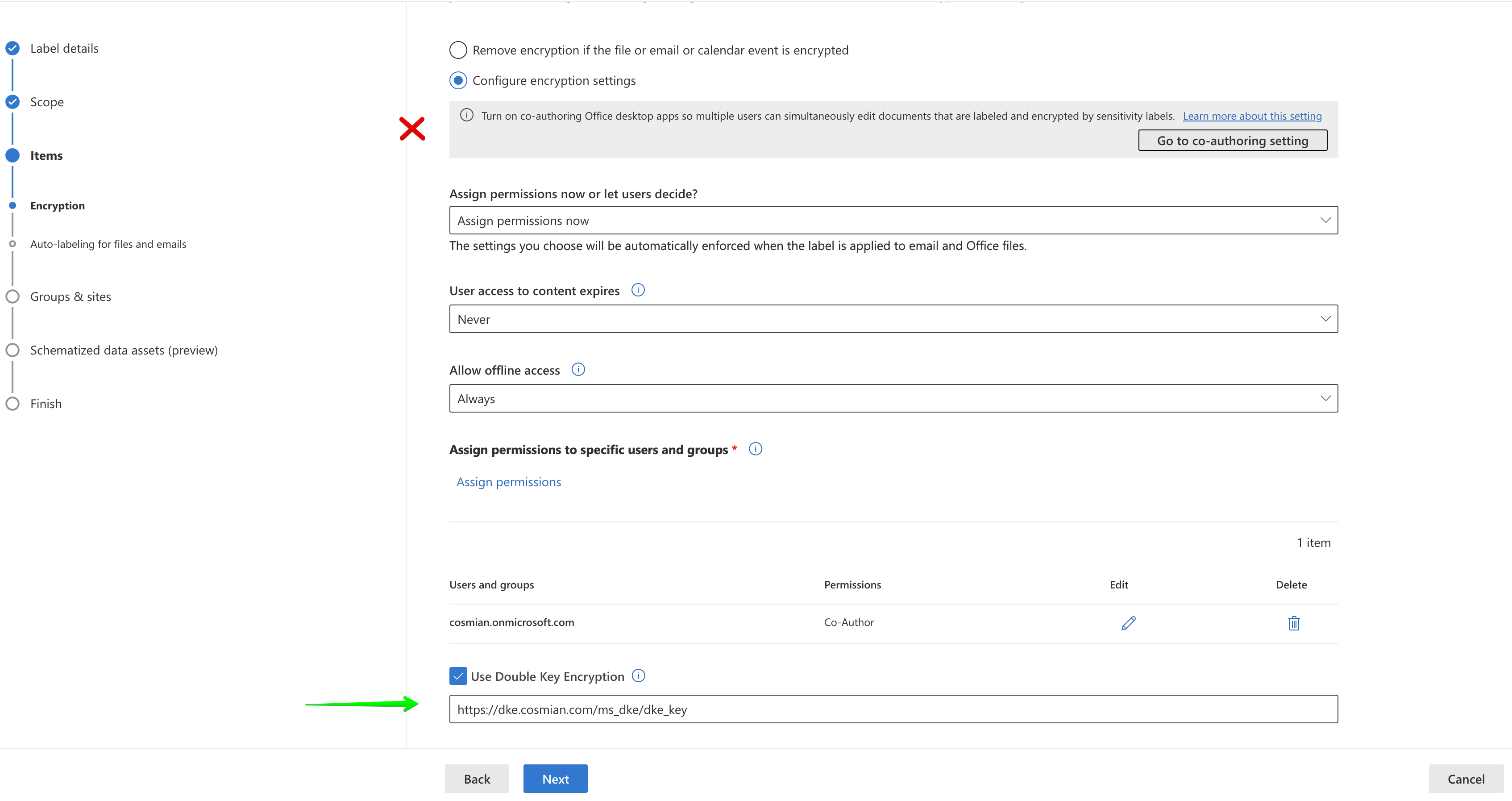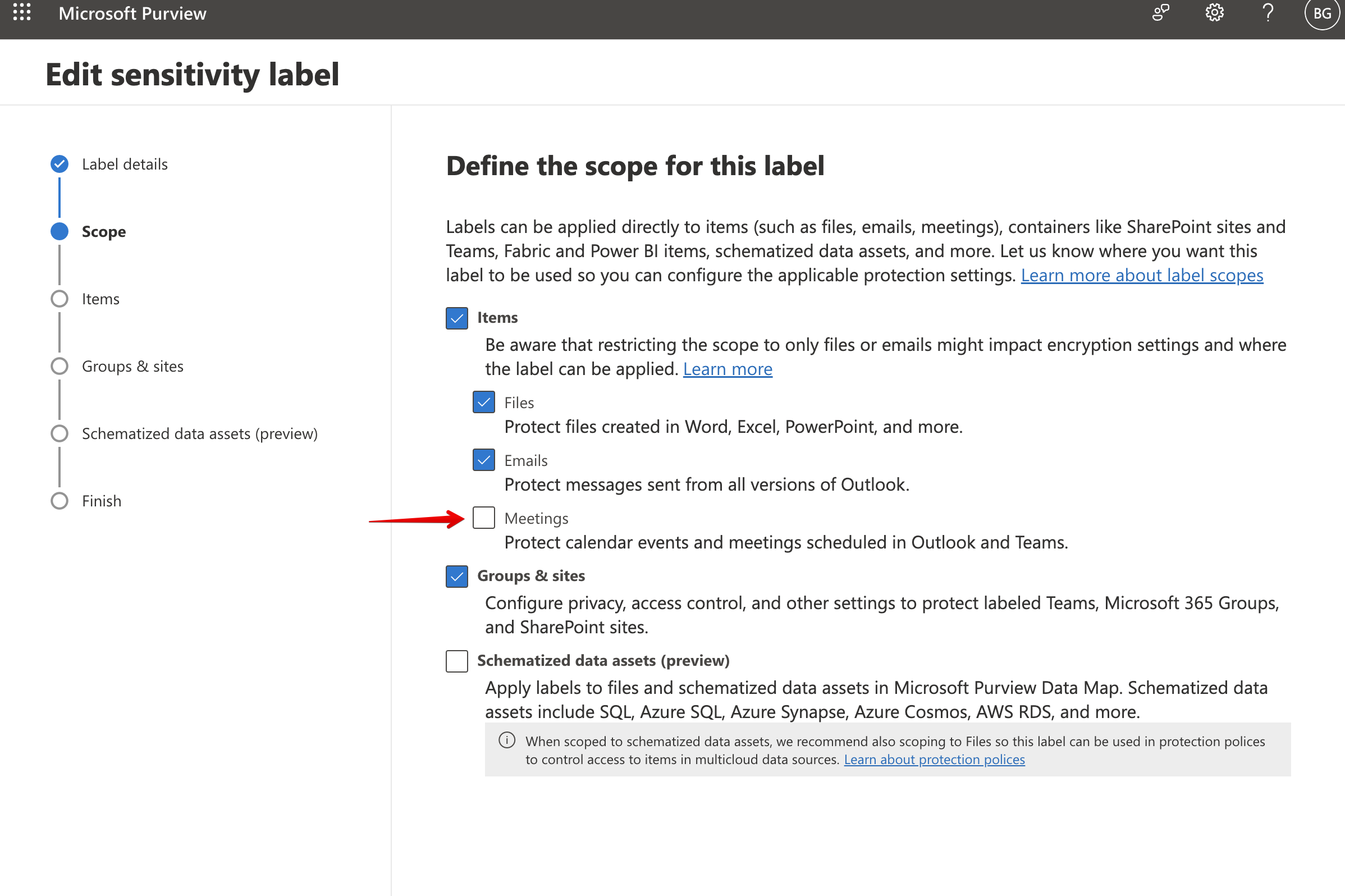Microsoft Double Key Encryption (DKE)
Microsoft Double Key Encryption (DKE) is a feature of Microsoft 365 that allows you to protect your most sensitive data by encrypting data on the client computer before sending it to Microsoft servers. One of the keys used to encrypt remains under your control and makes the data unreadable by Microsoft. This key is kept inside your instance of Cosmian KMS which exposes the required API to integrate with Microsoft DKE.
See How it works for details on the cryptographic process.
Microsoft Prerequisites¶
The DKE feature is currently only available for the Office Windows clients. In addition, to use Microsoft Double Key Encryption (DKE) you must have a Microsoft 365 Business Premium license and must have access to the Microsoft Purview compliance portal.
How it works¶
Once DKE is configured, the whole process consists in assigning a specific sensitivity label to a document. The label will indicate that the document is encrypted and that the key to decrypt it is stored in your Cosmian KMS.
Please check the dedicated Microsoft documentation for a complete overview of the feature.
From a cryptographic standpoint, the feature works as follows:
Before saving an encrypted document, the Office client will:
- Generate an ephemeral 128-bit AES key and use it to encrypt the document
- Call the Cosmian KMS to get your 2048-bit RSA public key (the Office client will cache the key for 24 hours)
- Use that key to wrap the AES key using the PKCS#11 CKM_RSA_PKCS_OAEP (NIST 800 56B Rev2) algorithm; the hashing algorithm is set to SHA-256 (see the list of supported algorithms for details)
- Send the wrapped AES key and the encrypted document to Microsoft servers, where Azure RMS will also wrap the wrapped AES key with their own key (hence the “double key” acronym)
Retrieving an encrypted document works as follows, the Office client will:
- Request Azure RMS to perform the first unwrapping using their key, to recover the wrapped AES key
- Download the encrypted document and the wrapped AES key
- Call your Cosmian KMS to unwrap the AES key using your private RSA key. Please note that the private RSA key never leaves the Cosmian KMS.
- Decrypt the document using the recovered AES key and display it.
Note: The Cosmian KMS implementation of the PKCS#11 CKM_RSA_PKCS_OAEP algorithm is FIPS compliant. The DKE API is therefore available on the Cosmian server running in FIPS mode.
Configuring the Cosmian KMS server¶
The Cosmian KMS server needs to be started with the --ms-dke-service-url <MS_DKE_SERVICE_URL> option.
The <MS_DKE_SERVICE_URL>should contain the external URL of this server as configured in Azure App Registrations
for the DKE Service
The URL should be something like https://kms.my_domain.com/ms_dke
Alternatively, you can set the KMS_MS_DKE_SERVICE_URL environment variable to the same value, or set the
corresponding entry in the server TOML configuration file.
No authentication => firewalling is critical
The Office client does not send any authentication information when calling the Cosmian KMS. Firewalling the Cosmian KMS server to only accept requests from valid Office clients is critical.
Running the KMS server in the cloud for DKE
It is possible to confidentially run the Cosmian KMS server in the cloud inside a Cosmian VM. However, due to the lack of authentication, and thus the need to firewall the server, one should make sure to use OS-level firewalling and not rely on the cloud provider’s firewalling capabilities, particularly if running on Azure.
Create an RSA key with tag dke_key¶
Using the ckms command line tool, create a 2048-bit RSA key with the tag dke_key:
The tag can be changed to any value, but it must be used in the URL of the sensitivity label in the Microsoft Purview compliance portal. See Create a sensitivity label for encryption for details.
Rotate the DKE key¶
If later on you need to rotate the DKE key, you can use the ckms command line tool to create a new key with a new tag.
You must then create a new sensitivity label where the Double Key Encryption URL ends with the new tag value.
See Create a sensitivity label for encryption for details.
Users should now select the new label when creating new documents. As long as the old key is available in the Cosmian KMS, users will still be able to open documents encrypted with the old key.
Configuring Microsoft DKE in Purview¶
Please follow the main documentation provided by Microsoft. The following paragraphs add details and tips to the process.
Activating the protection service from Azure Information Protection¶
The protection service must be activated in order to use DKE. If not activated, “Group and Sites” will not be available in the scopes of the sensitivity label.
Run PowerShell as Admin
In case of troubles with the execution policy, try
Get the status of the AIP service
You may have to connect to it first
If it is disabled, enable it
More options for phased deployments here.
Microsoft Entra configuration for encrypted content¶
Check if there is anything to configure.
Activate sensitivity labels for MS 365 groups¶
Sensitivity labels must be activated for MS 365 groups which are also called unified groups. The main documentation on configuring sensitivity labels is available here.
The objective is to set the EnableMIPLabels parameter to True at the Entra ID Directory level (which is set
to False by default), using Group.Unified template.
The
EnableMIPLabelsflag indicates whether sensitivity labels published in Microsoft Purview compliance portal can be applied to Microsoft 365 groups. For more information, see Assign Sensitivity Labels for Microsoft 365 groups.
To verify the current value of the EnableMIPLabels parameter, run the following command:
See this doc and Enable sensitivity label support in PowerShell which will probably require configuring groups first.
De-activate co-authoring in Microsoft Purview¶
Do NOT click the box on this page, doing so will prevent the use of DKE in Sensitivity Labels.
If you need to deactivate co-authoring, you can do so by running the following commands:
Install-Module -Name PSWSMan # if not already installed
Install-WSMan
Install-Module -Name ExchangeOnlineManagement
Import-Module ExchangeOnlineManagement
Connect-IPPSSession -UserPrincipalName you_admin_user@your_domain.com
Set-PolicyConfig -EnableLabelCoauth:$false
Create a sensitivity label for encryption¶
Navigate to Purview then Solutions > Information protection > Labels
Follow these instructions
to create the label.
Select Use Double Key Encryption on the encryption configuration screen and make sure
you do not activate co-authoring.
Use the correct URL
The URL must be set to a form similar to https://dke.acme.com/ms_dke/dke_key where
dke.acme.comis the address of the Cosmian KMS server. A valid certificate must be installed on the server.ms_dkeis the root of REST path for the DKE services.dke_keyis the tag set for the RSA key pair to use for this label.

Activating the label (scope) for meetings does not seem to work.
